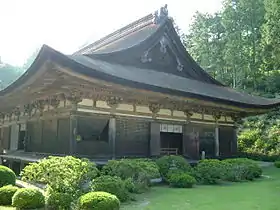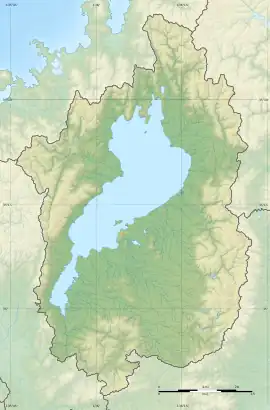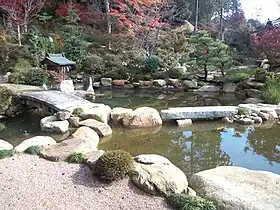| Zensui-ji | |
|---|---|
善水寺 | |
 Zensui-ji Main Hall (NT) | |
| Religion | |
| Affiliation | Buddhist |
| Deity | Yakushi Nyōrai |
| Rite | Tendai |
| Location | |
| Location | 3518 Iwane, Konan-shi, Shiga-ken 520-3252 |
| Country | |
 Zensui-ji  Zensui-ji (Japan) | |
| Geographic coordinates | 35°0′23.2″N 136°6′45.2″E / 35.006444°N 136.112556°E |
| Architecture | |
| Founder | c. Empress Genmei |
| Completed | c.708-715 |
| Website | |
| Official website | |

Zensui-ji (善水寺) is a Buddhist temple in the Iwane neighborhood of the city of Konan, Shiga Prefecture, Japan. It belongs to the Tendai school of Japanese Buddhism. Its main image is a hibutsu statue of Yakushi Nyōrai, which was carved in 993. Its Hondō is a National Treasure.[1]
History
The history of Zensui-ji is uncertain, as the documentary evidence of its foundation has been lost. The temple's legend states that it was founded by Empress Genmei during the Wado era (708-715), and that the tempe was originally called "Wado-ji". During the early Heian period, Saichō came to the temple to pray for rain, and converted it to the Tendai sect. Later, when Emperor Kanmu fell ill, Saichō sent water from a spring at this temple, and the emperor made a miraculous recovery. The emperor bestowed the name of "Zensui-ji" on the temple in commemoration of this event. At its peak, the temple grew to have 26 subsidiary temples, which occupied both mountains adjacent to the main temple.
The temple is 3.9 kilometers, or approximately a one-hour walk, from Mikumo Station on the JR West Kusatsu Line.
Cultural Properties
The Main Hall (Hondō) of Zensui-ji was built in the Nanboku-chō period and was completed in either 1364 or 1366. It is in the irimoya-zukuri-style and is a seven by five bay building with a hinoki cypress bark shingled roof. The building was designated a National Treasure in 1954.[1]
The temple also has many statues which are National Important Cultural Properties:[2]
- Yakushi Nyōrai, Heian period (the honzon of the temple)[3]
- Bonten and Taishaku-ten[4]
- Bishamonten, Heian period [5]
- Jikokuten and Zōjōten, Kamakura period[6][7]
- Shi-Tennō, Heian period [8]
- Fudō-Myōō, Heian period[9]
- Monjū Bosatsu in the form of a Buddhist priest, Heian period [10]
- Niō, Heian period[11]
- Shaka Nyōrai, in gold and bronze, depicted as an infant. Nara period. This statue is known to have existed in 762 AD when it was used during a Buddha's Birthday ceremony at Ishiyama-dera and is believed to have been made at the casting workshops at Tōdai-ji.[12]
See also
References
- 1 2 "善水寺本堂" (in Japanese). Agency for Cultural Affairs. Retrieved August 20, 2020.
- ↑ Shiga Prefecture List of Cultural Properties (in Japanese)
- ↑ "木造薬師如来坐像" (in Japanese). Agency for Cultural Affairs. Retrieved August 20, 2020.
- ↑ "木造〈梵天/帝釈天〉立像" (in Japanese). Agency for Cultural Affairs. Retrieved August 20, 2020.
- ↑ "木造兜跋毘沙門天立像" (in Japanese). Agency for Cultural Affairs. Retrieved August 20, 2020.
- ↑ "木造持国天立像" (in Japanese). Agency for Cultural Affairs. Retrieved August 20, 2020.
- ↑ "木造増長天立像" (in Japanese). Agency for Cultural Affairs. Retrieved August 20, 2020.
- ↑ "木造四天王立像" (in Japanese). Agency for Cultural Affairs. Retrieved August 20, 2020.
- ↑ "木造不動明王坐" (in Japanese). Agency for Cultural Affairs. Retrieved August 20, 2020.
- ↑ "木造僧形文殊坐像" (in Japanese). Agency for Cultural Affairs. Retrieved August 20, 2020.
- ↑ "木造金剛二力士立像" (in Japanese). Agency for Cultural Affairs. Retrieved August 20, 2020.
- ↑ "金銅誕生釈迦仏立像" (in Japanese). Agency for Cultural Affairs. Retrieved August 20, 2020.
External links
![]() Media related to Zensuiji at Wikimedia Commons
Official website
Media related to Zensuiji at Wikimedia Commons
Official website
- Shikoku 49 Yakushi pilgrimage website (in Japanese)
- Shiga-Biwako Visitor's Guide (in Japanese)